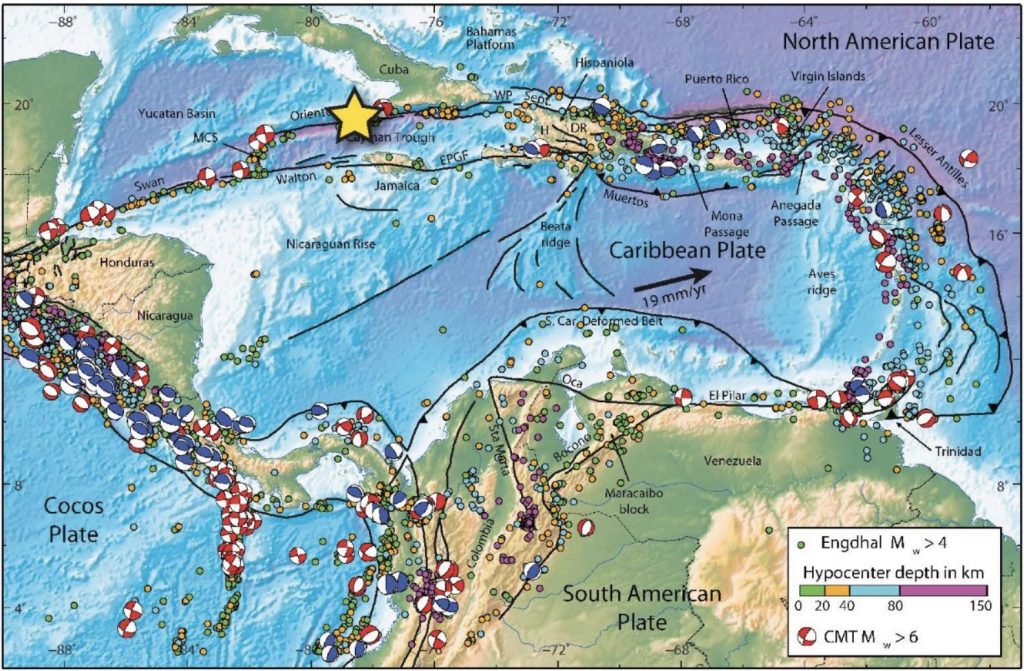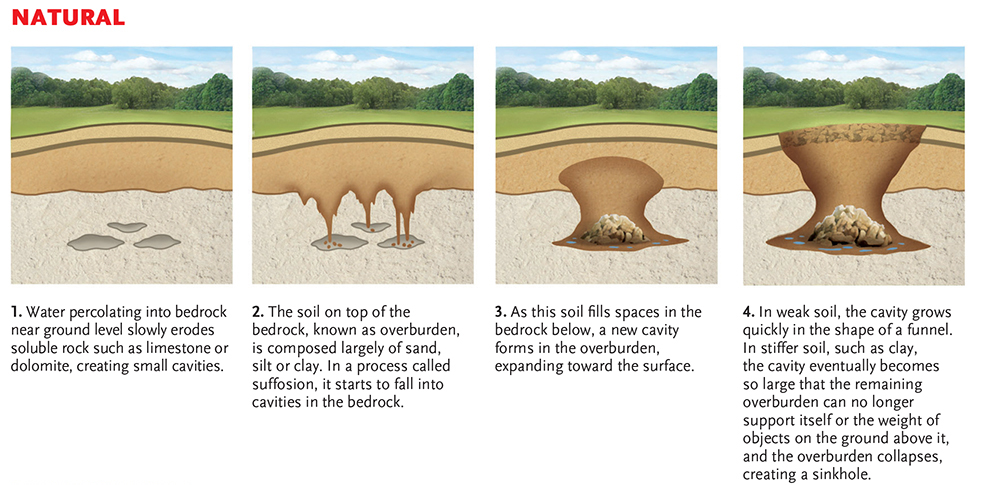By Tiegan E. Hobbs, Ph.D., Postdoctoral Seismic Risk Scientist, Temblor (@THobbsGeo)
A large earthquake in the Caribbean Sea, unrelated to the recent Puerto Rico earthquake, caused sinkholes and liquefaction. Despite alerts, no significant tsunami resulted from this strike-slip earthquake.
Citation: Tiegan E. Hobbs (2020), More unrest in the Caribbean as Jamaica is struck by a magnitude 7.7 earthquake, Temblor, http://doi.org/10.32858/temblor.069
On January 28 at 2:10 p.m. local time, a magnitude-7.7 earthquake struck in the Caribbean Sea between Jamaica, Cuba and the Cayman Islands. Less than three hours later, a magnitude-6.1 earthquake struck roughly 200 kilometers (125 miles) to the west, near what is believed to be the edge of the rupture zone of the mainshock. This aftershock sequence was very close to the Cayman Islands, and has continued to be more active than the epicenter. Although the mainshock was felt as far away as Florida, the most intense shaking observed near the epicenter was less than what would be expected as the maximum shaking for an average lifetime. This means that while this earthquake was quite large, it’s not the strongest shaking that locals should be prepared for. That said, damage across the Caribbean was relatively low-level and the United States Geological Survey (USGS) doesn’t expect any loss of life to be reported.

Is This Event Related to the Puerto Rico Earthquake From Earlier This Month?
Given the recent January 7, 2020, Puerto Rico earthquake, it’s natural to wonder if the two events may be related. As seismologist Dr. Lucy Jones, founder of the Lucy Jones Institute for Science and Society, has reiterated: earthquake triggering can only happen within a few times the fault length. Because these events were close to 1,300 kilometers (800 miles) apart, and because the Puerto Rico earthquake was only about 24 kilometers (15 miles long), there is no way they could be related to one another.

It’s not just the large distance between the events that suggests they weren’t related. They’re also on different faults. The Jamaica mainshock and its aftershocks are believed to be on the left-lateral (meaning the other side of the fault is always moving to the left relative to an observer), strike-slip (meaning purely horizontal motion) Oriente Fault, which marks the main plate boundary between the Caribbean and North American plates here. The Puerto Rico earthquake of January 7th was on an oblique (meaning somewhere in between purely horizontal and purely vertical motion) fault away from the main plate boundary in that area. Near Jamaica the plates are simply sliding past one another, like two ships passing. In Puerto Rico, however, complex fault networks result from the Caribbean plate crashing into the North American. Therefore, the two mainshocks are definitely not occurring on the same structure.
No Significant Tsunami Despite Alert — This Time
Although a tsunami threat message was issued based on the large size and shallow depth of the Jamaica mainshock, only one tide gage registered a wave from this earthquake. There, in the Cayman Islands, it was measured at 11 centimeters (5 inches). The reason this earthquake produced such a small tsunami wave is that it ruptured in a strike-slip sense. In this case, the two plates move horizontally relative to one another, rather than vertically. Large vertical motions create larger tsunamis, just like a stone dropped vertically into a puddle.
Despite the lack of significant waves, it remains important to always heed alerts issued by the Tsunami Warning Centera>. Even without a formal warning, one should always seek higher ground in the event of a felt earthquake that is both long and strong.
Earthquake in the Cayman Islands 7.7
the ground got hot and the sink holes started to form!! #caymanisland #earthquake pic.twitter.com/BRNYRIs3IE
— woahtino (@tino_lewis) January 28, 2020
Social Media Provides Insights Into Damage
On Twitter, videos and pictures document the extensive liquefaction that occurred in the Cayman Islands. Other videos show deep sinkholes forming. Both of these phenomena have to do with unstable conditions and plentiful water beneath the surface. Sinkholes form when the bedrock is broken down by groundwater, and the soil slumps away into the hole. This can leave only a thin layer at the surface, which is then shaken apart during the earthquake.

While it is frightening, sinkhole deaths are “extremely rare” according to Clint Kromhout, a geologist with the Florida Geological Survey speaking with the Orlando Sentinel back in 2013.
Historical seismicity map of the region of today's M7.7 quake near Jamaica shows that there have been other M7+ earthquakes on this strike-slip system, but today's event is one of the largest in the past hundred or so years. pic.twitter.com/xa1xqnV9KC
— Jascha Polet (@CPPGeophysics) January 28, 2020
Leveraging the speed of communication on social media, scientists were quick to start talking about this large earthquake by, for example, comparing it to all other recorded seismicity in the region. Another scientist used augmented reality to look at the distribution of earthquakes in three dimensions (3D), allowing us to view data the same way we view the world rather than in flat representations. Such events will continue to improve our scientific understanding and the technologies we use to study natural phenomena.
Upgraded M7.7 earthquake between Jamaica and Cuba. Strike-slip so hopefully minimal tsunami #StaySafe. Not common place for earthquakes of this magnitude – in the area only a M6.2 (2007) and M6.8 (1992). Here's all events since 1970, today's is the pink one: pic.twitter.com/FrGEButsbk
— Martin Pratt (@sympathy4data) January 28, 2020
References
Symithe, S., Calais, E., De Chabalier, J. B., Robertson, R., & Higgins, M. (2015). Current block motions and strain accumulation on active faults in the Caribbean. Journal of Geophysical Research: Solid Earth, 120(5), 3748-3774.
- Dual disaster planning, communication and reason for hope: a discussion with professor Sam Montano - April 14, 2020
- Significant Idaho earthquake unlikely to cause unrest in Yellowstone - March 31, 2020
- Earthquake strikes Utah amid COVID-19 pandemic - March 18, 2020
